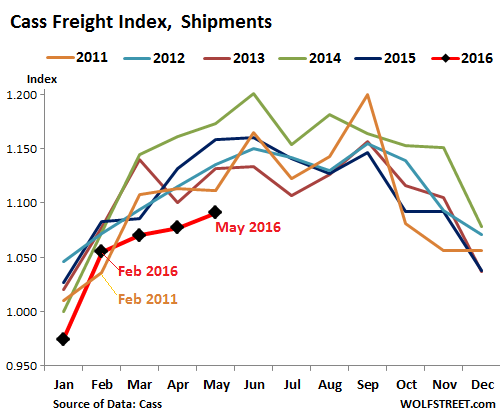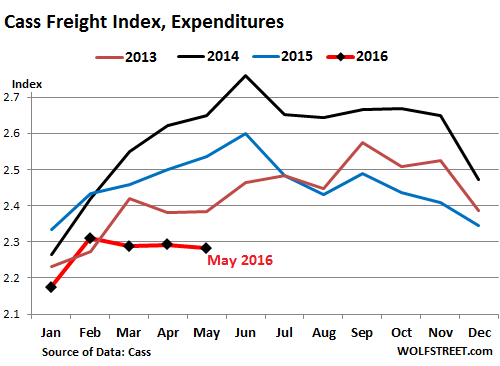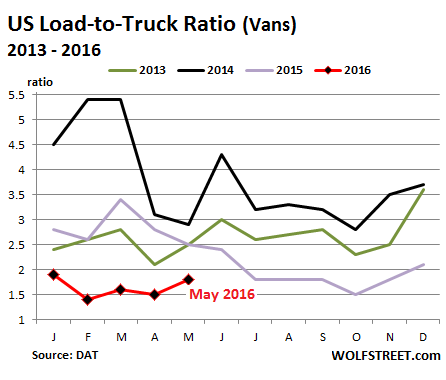Goods economy sinks, drags down trucking & railroads.
“May is usually a relatively strong month for freight shipments, but given the high inventories with ever slower turnover rates and the decline in new production orders, May could be another soft month,” predicted Rosalyn Wilson at Cass Transportation a month ago. It has now come to pass – only worse.
Freight shipments by truck and rail in the US, excluding commodities, fell 5.8% in May 2016 from the already anemic levels in May 2015, and 7.0% from May 2014, according to the Cass Freight Index, released today. It was the worst May since 2010.
“This year we have failed to see the robust growth in shipments that we expect to see this time of year,” Wilson lamented.
In fact, aggregate shipment volume over the first five months, according to the index, was the worst since 2010. And freight is one of the most reliable gauges of the goods-producing economy.
The Cass Freight Index is based on “more than $26 billion” in annual freight transactions by “hundreds of large shippers,” according to Cass Transportation. It does not cover bulk commodities, such as oil and coal and thus is not impacted by diminished oil-train activity and collapsed coal shipments. The index is focused on consumer packaged goods, food, automotive, chemical, OEM, heavy equipment, and retail.
The Index is not seasonally or otherwise adjusted, so it shows strong seasonal patterns. In the chart below, the red line with black markers is for 2016. The colorful spaghetti above that line represents the years 2011 through 2015. The only month this year that was not the worst month since 2010 was February; only February 2011 was worse. That’s how bad it has gotten in the Freight sector:

“Truck tonnage continues to slide for both linehaul and spot markets,” according to the report. And railroads are also singing the blues.
The Association of American Railroads (AAR) reported earlier that May carloads, which include commodities, had plunged 10.3% year-over-year, while containers and trailers had dropped 3.3%, for a combined decline of 6.8%.
“Most economists think the economy has picked up in the second quarter from the dismal 0.8% growth in the first quarter, but so far railroads aren’t seeing much of it,” said AAR Senior Vice President of Policy and Economics John Gray when commenting on the dismal report.
“A variety of environmental and market forces continue to punish coal, and high business inventory levels and excess truck capacity, among other things, are pressuring rail intermodal volumes,” he said, blaming in part competition from desperate truckers for the railroads travails.
In the Cass Freight Index report, Wilson worries about the “volatile” economic outlook: “What is perceived as a strong sign one week often looks like a sign of economic weakness the next,” she said. “The global economy is facing many unsettling influences, such as Britain’s possible exit from the EU, China’s economic woes and currency problems, and oil prices.”
This “volatile” outlook and the “unsettling influences” impact the dollars and cents of the freight sector.
Freight payments edged down 0.4% in May from April, a seasonal anomaly, and “completely opposite of the upward trend of previous years” for the period, Wilson pointed out. So freight payments plunged 10.1% from May 2015 and 13.8% from May 2014, on lower volume, lower rates, and a drop in fuel surcharges that trucking companies had been able to impose during the heyday of the post-Financial-Crisis economy:

What’s weighing on rates? The year-over-year downturn in shipments and the “abundant available capacity.”
Trucking overcapacity, after a big build-out of the fleet during the years of optimism, particularly 2014, has now become an issue. Transportation data provider DAT tracks national spot-market demand for trucks and availability of trucks via its load-to-truck ratio. The spot market for the largest category, van-type trailers, continued to stew in its own juices: In May, the load-to-truck ratio for vans plunged 28% from May 2015 and 38% from May 2014. It has been ugly all year (red line):

For companies having to send goods across the country, there is a bright side in this misery, according to the report: “more bargaining power to drive down rates.”
For others, not so much. Trucking companies, such as Swift, the largest in the US, have started to idle part of their fleet. And they have slashed orders for new trucks. Truck manufacturers along with engine and component suppliers are going through waves of layoffs. Heavy truck dealers see their sales plunge and are getting worried. Railroads are cutting back [haunting pictures of 292 majestic Union Pacific engines idled in the Arizona desert].
Everyone in the transportation sector is trying to slash expenses. So the malaise, caused by the weak goods-producing economy, is cascading into the broader economy.
It might not turn around on a dime. “Predicting the second half of 2016 and beyond gets more complicated with each economic report released,” Wilson lamented. “We basically are at a standstill as we wait for the forecasted strengthening.”
Alas another brake shoe may be about to drop on the economy. Read… OK, I Get it, the US is a Service Economy, but this Looks Terrible
Enjoy reading WOLF STREET and want to support it? You can donate. I appreciate it immensely. Click on the mug to find out how:
![]()


Certainly there is a decline in business. I see the Union Pacific yard in Missouri Valley, IA is packed with locomotives. The BNSF just parked another 40 locomotives in Willmar, MN. At International Falls, MN there is a yard full of brand new frack sand rail cars that have never been used. The sad reality of low oil prices and lack of demand from oil exploration. This has rippled across the entire economy causing fleets of rail cars being parked across North America. Unless thing turn around quickly the bad news will soon reach main street. The cycle down has begun.
George; Rail Man, I have been told that for every loco you see in a freight train there will be at least 30 cargo cars. Up to 50 per loco if running in flatland.
I would sure like to have an accurate figure.
300 idle locos X 30 cars = 9000 idle cars at a MIN
Find some idle rail track on the SF peninsula and those box cars could be converted into rental housing or condos.
Here’s a 40 foot caboose for sale @ $13,000
http://www.sterlingrail.com/classifieds/classified.php?id=15883
All aboard!
I think the bad news hit main street in 2008. It seems to be a sign of our insanity and our failure as an intelligent society that we use gas guzzling trucks to move goods cross country while CO2 levels top 400ppm and the Planet burns. We act as if everything is hunky dory. Reality is coming!
These charts are dismal and not likely to improve very much going forward. Even if we were producing, where would we sell? Other country’s economies are as bad or worse than ours.
If Brexit happens on Thursday, the waters will be even muddier because London is still a global financial/banking center – that is about all the Brits still have. That sector will be jeopardized because geopolitics will enter into the UK relationship with Europe which has never been good anyway. I believe, contrary to some analysts, the EU will go punitive. Bound to cause some serious global ripples. Don’t place any chips on the table until after Thursday.
Update on the mothballed U. Pac. locomotives on the siding in AZ:
I checked them again June 18. More have been added since your article from early May. I would estimate 20 or so have been added to the 292. The string is approaching where the siding goes under I-10. I would say less than 100yds left to I-10. The last loco to be added carries ID#9796. You don’t even need binocs to read the numbers now. For any doubting thomas’s; exit 292, Empirita rd. and from there westward to mm288 or 289 by circuitous route.
This is anecdotal: I have heard U. PAC has agreed to store locos for CSE who running out of storage sidings/yards of their own.
wolf if you can find some info for truck traffic across Windsor and Detroit on the ambassador bridge, you might find some good economic clues. its the busiest land crossing between Canada and the U.S. just saying. gives you another alley to view trade.
Thanks. I’ll check into it.
Also read today that canadian pacific railway is expecting second quarter revenues down. Something like 12%. So its happening up north as well.
I hear this. and i don’t doubt it. but why are the tracks in houston, tx so full of trains being assembled[miles long]?
and why are there more 18 wheelers on interstate 45 than i have seen in decades?
Trains are being built because they were ordered three years ago and the penalties for cancelling orders are often so punitive it’s just cheaper to have them assembled and then mothballed.
Regarding lorries. The situation I see one continent away is radically different: lorry traffic never really recovered after 2009 and has rolled over and died since May 2014.
If the same patterns apply those lorries are traveling at half or even less capacity: freight companies need to stay in business and to stay in business they’ll even take contracts they would have turned down in 2007.
Generally speaking the closest to maximum capacity, the better, but these days you cannot afford to be picky or even to wait to fill a trailer: competition abounds and there aren’t really those many goods to be shipped around. Even retail (or consumer discretionary) is stagnating.
The only exception so far has been automotive. Cars sell like hot bread, proving my mother is right when she says “When they sell so many cars but greengrocers have to give away fruit and vegetables to avoid having them rot away, you know you are in serious troubles”.
This is one of the many mysteries of the present economy: how in the Hell can people afford so many brand new cars if fundamentals stay the same? Yes, I know: loans. But car loans these days, despite seven years and counting of ZIRP’s, NIRP’s and other assorted absurdities, are far higher than they were in 2007. Minimum EAPR here is 5%, with 8% being typical. Back in the days 0% EAPR wasn’t unheard of but typical was around 2%.
There’s something broken here, and I am not talking about my heart.
People can buy cars on 60 or 72 month terms to drive down monthly payments. Can’t track down the percentage, but the number of borrowers that are upside down in their loans has grown dramatically over the last few years. In middle Tennessee, I see lots of young people driving a Lexus or Range Rover, a car I would never have dreamed of owning at that age. But while they are driving a nice car, they can’t afford to spend money on other items which is one of the reasons why retailers are hurting.
I’ll just say, there was no shortage of 18 wheelers during my trip on interstate 40 and 81 last week. Not sure I could differentiate a 5~6% slowdown but trucks were thick as fleas… Given diesel prices are dirt cheap (why does nobody discuss this much at all?), perhaps trucking is giving intermodal rail a run for their money or not?
Man, there were some rough sections on this route as usual, another round of repairs are needed….
I go by the Swift yard in Duncan SC every day. The storage yard has been chock full of trucks and trailers for months now. Every once in a while I see a few trailers with loads on them or a loaded tractor trailer but there a only a very few of those. They have a side yard close to the road and outside their fenced in area where they store lease trucks. This yard has been mostly empty so the leased vehicles are doing OK. This morning I went by this yard and it was absolutely packed, as many as could be packed in, with Swift fleet trucks. They even had trucks parked on the roadway into the fenced in area.
Duncan is absolutely chock full of trucking companies. Old Dominion, Georgia Pacific, Averitt, FedEX which also maintains two 757s at GSP airport, UPS and a whole host of other trucking outfits. These all have lots that are packed with parked vehicles and trailers as have other, lesser known trucking outfits.
There is a lot of railroading in the area. They recently built an inland port 3 miles west of downtown Duncan and along the railroad line which runs through downtown Duncan, such as it is in Spartanburg county close to the Greenville county line at the behest of BMW which uses it to export partially assembled vehicles in containers. The port storage area is divided into two main sections, one for BMW and the other for miscellaneous cargo. The miscellaneous cargo stack has slowly been shrinking over time and there are a lot fewer trains than there used to be 6 months ago. The BMW stack never changes size, it is always as high and as wide as the cranes allow so I believe that it is being used as a storage facility.
Every once in a while I go by the rail yard in Spartanburg and I see more and more cars and engines parked on the sidings. I can’t get a count because I go by too fast but I do get a look at the amount of space they take up on some of the sidings and free space on those sidings appears to be shrinking.
I realize this is all anecdotal stuff but I also think that the thousands of tractor trailers I see parked are an indicator of hard times for the folks that brings consumer goods to their final destinations.
Thanks, Thomas, for the detailed on-the-ground report. This “anecdotal stuff,” as you call it, is a real addition to the data (going in both directions … because nothing is ever totally clear and simple).
Yes, it did seem there were quite a few tractors in the yards (used sales lots?), come to think of it seemed like most of the trucks actually hauling appeared to be new(er) ones?
Those funny guys, anything with 500,000 miles on it is retired? I don’t see how/where all those used trucks can go back on the road though, there wouldn’t be enough space for anyone else.
Usually at wolfstreet you can’t expect to find good news, is this site a PM oriented sales tool?
I am sitting less than 100 feet from the rails and it used to be noisy….now it is silent…only 2 or 3 trains/night. This a link to an historical map of the 1865-1869 timeline of the building of the line from Omaha thru Nebraska and Wyoming to Promontory Point. http://www.up.com/cs/groups/public/documents/up_pdf_nativedocs/pdf_eot_historical_up_maps.pdf
One word: Brutal.
Wolf Street – The thinking man’s Zero Hedge.
I like Wolf Street for well thought out comments. While I read Zero Hedge for some of the worthwhile posts, the comments section is pure jibberish.
The Great Pumpkin bought Watkins & Shepard and Lodeso, wonder how much they paid for those? Enough to fix their crumbling operations centers and other infrastructures? They should hire world class brain surgeon Dr. Ben Carson.
The hubs are stuffed full of old tractors and trailers that they cannot sell. 1700 overpriced tractors on their website. Then there’s about that many old lease tractors that haven’t been picked up by whomever they leased them from.
UPS, FedEx and a few others are bigger than Swift aren’t they?
http://www.dat.com/resources/trendlines
My average length of haul has improved substantially with the recent bounce. After I unload this morning in Marquette, Michigan then it’s 1200 miles Quinnesec to The Rock, Georgia. Squeaking wheel gets the most grease and I sure been squawking. Does the bounce have any wheels or is it a dead cat?
Along the I10 in AZ there’s still many locomotives sittung idle.
does seem to be more trucks on the road. railroads are a utility. solid buys at this level, if you like utilities. i own all four, but they sure are boring, just a 2x 10 year treasury investment.
I would pay $100 to drive a locomotive for an hour or two. Untapped market!
FWIW, They handle like they’re on rails…..
I run 6 trucks hauling heavy machinery, I have not seen it this slow in years for both local and long distance trucking its like the perfect storm. Many oilfield trucks now looking to haul basic freight just to keep the wheels turning and imports and exports seem to be at a standstill , brokers and companies like Uship have not helped, rates are back to 1990s levels or below operating cost.
Thanks, Rob, for your observations!